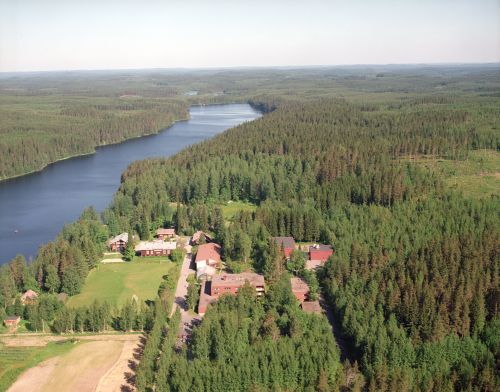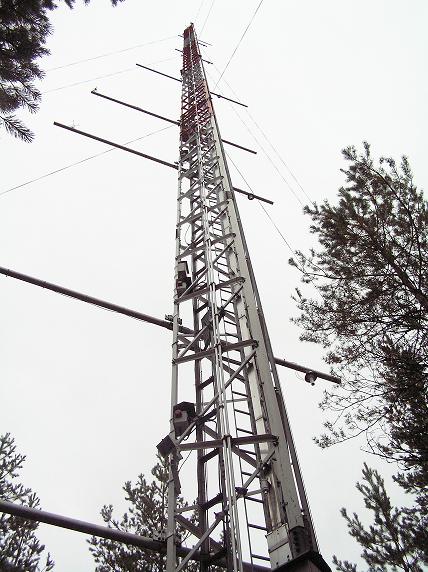Summary
• Coordinates: 61°51’N, 24°17’E
• Height: 127 m tower
• Base level: 181 m ASL
• Country: Finland
• InGOS observations: CH4, N2O, SF6, H2
• Responsible partner: University of Helsinki (UHEL)
• Responsible PI: Ivan Mammarella (ivan.mammarella@helsinki.fi)
• TNA access: Access request page
• Website: http://www.atm.helsinki.fi/SMEAR/index.php
General

Surroundings of sMEAR II station at Hyytiälä
The heart of SMEAR is the Finnish Centre of Excellence (FCoE) on physics, chemistry, meteorology and biology of climate change and air pollution. The SMEAR station offers comprehensive data sets, and all data is available for visitors.
The site offers a calibration tank, by which soil chambers can be tested and intercompared for trace gases. It has been utilized for carbon dioxide and it can be provided for N2O tests with small modifications. A tall tower of the height 127 m with profile measurements of methane and N2O is under operation during the project and can be utilized for a footprint campaign.
The SMEAR II (Station for Measuring Forest Ecosystem-Atmosphere Relations) station is located in a rather homogenous Scots pine (Pinus sylvestris L.) stand on a flat terrain at Hyytiälä Forestry Field Station of the University of Helsinki (61°51’N, 24°17’E, 181 m above sea level) 220 km NW from Helsinki. The managed stand was established 1962 by sowing after the area had been treated with prescribed burning and light soil preparation. The station represents boreal coniferous forests, which cover 8% of the earth’s surface and store about 10% of the total carbon in the terrestrial ecosystem. The biggest city near the SMEAR II station is Tampere, which is about 60 km from the measurement site with about 200 000 inhabitants. Another long-term field site for carbon (carbon dioxide, methane and VOC) and energy exchange studies and soil (peat) processes is located close to the SMEAR II station at the Siikaneva wetland (fen) area. SMEAR II is also an Integrated Carbon Observation System (ICOS) site.
At SMEAR II measurements are carried out at a number of storage pools and interfaces involving three different layers, extending from the soil to the atmosphere. Several different methods, operating simultaneously but at different spatio-temporal scales, are applied to monitor the material and energy fluxes between the different pools, aiming at understanding the processes responsible for these fluxes. For example, the surface between a tree and the atmosphere, or between the soil and the atmosphere, can be enclosed in a chamber, and the corresponding flux of interest can then be determined from the mass balance of the chamber. Turbulent fluxes can be measured by micrometeorological techniques. Concentration gradients in the air and soil can also be used for making flux estimates by applying available transport coefficients.

SMEAR II tower
The main components of SMEAR II are i) an instrumented, 127 m tall mast, ii) systems for monitoring aerosols and air ions, iii) instrumentation for monitoring tree functions and radiation (by two 25 m towers) and iv) two instrumented mini catchments. The mast monitors CO2, H2O, CO, O3, SO2, NO, NO2, temperature and wind speed profiles, properties of solar and thermal radiation of the stand and fluxes of CO2, H2O, O3, aerosols, and several volatile organic compounds between the canopy and atmosphere. The mast measurements are usually reported as half an hour means. Aerosol and ion size distributions are measured in order to be able to study ion, cluster and aerosol dynamics. Chamber techniques are used to monitor tree processes generating the fluxes between trees or soil and the atmosphere. The most relevant processes are: photosynthesis, respiration, transpiration, NOx emission and deposition, O3 deposition and emission of volatile organic compounds. The fluxes between the soil and the atmosphere, as well as between the soil and the canopy, are also important. The catchments are closed with a dam, and the run-off from the area is monitored. The leakage of substances with the run-off is monitored by taking samples for chemical analysis. The water content and tension, CO2 and temperature profiles are monitored. Solar radiation is the source of energy for several processes in the trees and the atmosphere. Therefore, irradiance, diffuse irradiance, photosynthetically active radiation and radiation balance are monitored above the canopy. Stem diameter changes are monitored both above and under bark continuously with a precision of less than 1 μm. This allows us to indirectly estimate the water tension in xylem and phloem, which is an ecophysiologically important parameter, but very difficult to determine.
The present instrumentation at SMEAR II includes detailed in-situ aerosol physical characterization (AIS/NAIS, DMPS; APS) size distribution 1nm – 20 000 nm), in-situ aerosol chemical characterization (AMS, HTDMA, VDMPS), aerosol density (ELPI/DMPS), aerosol optical properties (nephelometer, aethalometer), in-situ cloud condensation nuclei concentration (total and size segregated CCN), sun photometer (Cimel CE-318, part of AERONET) for column aerosol burden, ceilometer, trace gases (sulphuric acid, OH, O3, NO, NO2, NOx, ammonia, precursor gases for aerosol particles (VOC, with PTRMS, sulphuric acid with CIMS), green house gases (ICOS site), ion chemistry (API-ToF), solar radiation (spectroradiometer, UVA, UVB, PAR, Global, IR, albedo), radon, external radiation, soil chemistry and dynamics, forest growth from cell level to canopy level.
Modality of access under this proposal:
The heart of SMEAR is the Finnish Centre of Excellence (FCoE) on physics, chemistry, meteorology and biology of climate change and air pollution. The SMEAR station offers comprehensive data sets, and all data is available for visitors. There are no principle time limits to perform observations at the site as long as it does not interfere with other projects.
Support offered under this proposal:
The site offers a calibration tank, by which soil chambers can be tested and intercompared for trace gases. It has been utilized for carbon dioxide and it can be provided for N2O tests with small modifications. A tall tower of the height 127 m with profile measurements of methane and N2O is under operation during the project and can be utilized for a footprint campaign.
In general, scientific and technical support to users is provided through collaboration with existing research and monitoring activities at the site. The continuous technical support is available. Depending on the project, the research is carried out co-operation with several post-graduates and senior group members. The capacity of Hyytiälä Forestry Field station (where SMEAR II is operating) to accommodate and to provide all necessary logistic support is superb. Hyytiälä has 150 beds. Visiting scientists can always be accommodated at Hyytiälä. Raw data collected at SMEAR II station is available on-line. At SMEAR station, the linking of visitors’ instruments with the existing measuring setup is easy and a necessary technical support is offered. Whether visiting scientists are using the data obtained with existing measurements facilities or bringing their own instrumentation, their degree of independence is high. Coordinating the research efforts between the host group and the visiting scientist will be emphasized when the visitors have common interests with host group so that maximal mutual benefit can be gained.
SMEAR II has a high profile when it comes to visibility and relevance in the atmospheric research community. SMEAR II is a key station in several observational and also experimental networks. Particularly the combination of continuous, comprehensive measurements and new and state of the art instruments coupled to the available expertise makes the use of the site for further research highly attractive in the European context. This is also shown by the number of visiting scientists and international field campaigns over the last few years.
